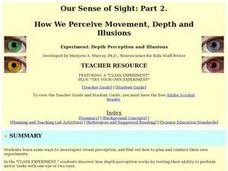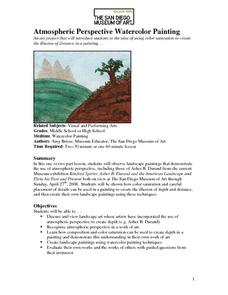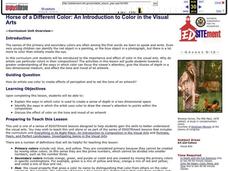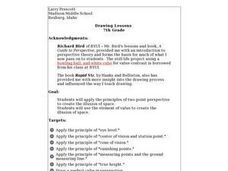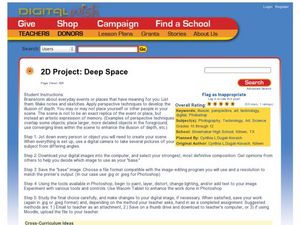Curated OER
Lesson: Urs Fischer: Your Choice: Reality or Illusion?
Young analysts write a comparative essay, but about what? They compose a paper based on several critical discussion about reality and illusion, and how both are blurred in art. They analyze several theatre pieces that exemplify Brechtian...
Curated OER
Geometric Illusion Banners
Students explore the composition of 3-D optical illusions by analyzing and combining 2-D visual elements graphically in banner form. They dissect the designs to undercover the mathematical elements of the illusion.
Curated OER
How We Perceive Movement, Depth and Illusions
Middle schoolers examine how depth perception works through a class experiment. They design and perform their own experiment that investigates visual illusions.
Curated OER
Horse of a Different Color: An Introduction to Color in the Visual Arts
Students identify ways in which the artist uses color to draw the view's attention to points within the composition and creates a sense of depth. They discuss the effect of color on the tone and mood of an artwork.
National Gallery of Canada
My Upside-Down World!
M.C. Escher is famous for creating optical illusions. Examine this effect in several of his works and discuss the techniques involved. Inspired by the discussion, learners create an imaginary 3-D world inside of a box using various...
University of Minnesota
Beautiful Brain: Do You See What I See?
Can art play tricks on your eyes, and can a still painting really appear to vibrate? The second lesson in a four-part series discusses the way our beautiful brains translate visual images. It highlights the style of optical art and...
Curated OER
Optical Illusion Vase
Learners draw an optical illusion. In this optical illusion instructional activity, students create the optical illusion vase. Learners draw a profile and repeat the drawing in reverse creating the vase image.
Curated OER
Illusions of Depth
Third graders practice drawing a landscape to show an illusion of depth. In the drawing, they can put whatever objects they choose to but have to remember to show depth. They explain how overlapping and size differences show...
San Diego Museum of Art
Atmospheric Perspective Watercolor Painting
How do artists create the illusion of depth and distance on a flat surface? Young landscape painters explore techniques like color saturation and detail placement that create atmospheric perspective.
Curated OER
Geometric Optic Spinner
Students investigate the concept of an optical illusion and how they are used. They conduct an information search of how the eye works. The information is used in order to set the context upon the creation of a personal optical illusion.
Curated OER
Applied Science - Science and Math Post-Lab
Students explore optical illusions. In this Applied Science lesson, students view optical illusions and record the data of what they see. Students graph the data that they collect.
LABScI
Vision Lab: The Eye
Our bodies have some amazing capabilities, but there are some limitations. Explore the limitations of the human eye through the eighth lab activity in a series of 12 biology lessons. Individuals measure their own peripheral vision...
Curated OER
Using Lines, Dots, And Shapes To Create the Illusion O
Students create the illusion of texture using lines, dots, and shapes in a rendering of an animal.
Curated OER
Optical Illusion
Students practice creating optical illusions as well as discerning how perception of information may change its characteristics. They distinguish between an equilateral triangle, endpoints, vertices's, and segments of triangles. The...
Curated OER
Horse of a Different Color: An Introduction to Color in the Visual Arts
Students examine how artists use color to create a sense of depth in a two-dimensional space. They view and analyze prints, complete worksheets, and write a paragraph on how color is used to draw the viewer's eye to a central figure.
University of California
The Civil War: Effects of the Civil War
Imagine being on the front line of the Civil War —from the front porch of your own house. Scholars use visual evidence from primary and secondary sources to analyze the impact of the Civil War on all Americans. They examine the research...
Curated OER
Drawing Lessons
Seventh graders complete a visual acts project that focuses on eye level, center of vision, station point, cone of vision, vanishing points, true height, and drawing a box in two point perspective. They work on a number of still life...
Curated OER
Exploring Optical Movement in Art
Students describe, represent and analyze patterns and relationships using shapes. They create simple geometric patterns. They demonstrate increasing technical ability and skill to complete visual arts assignments.
Digital Wish
2D Project: Deep Space
Using a digital camera, Photoshop, and a desktop paint program, learners will explore perspective techniques. They apply perspective techniques to develop depth illusions within a scene. The lesson employs both traditional art and...
Curated OER
Two-Point Perspective
Seventh graders will learn to create the illusion of depth on a two dimensional surface using the technique of perspective.Analyze famous works of art and photographs of local architecture and identify how each is using perspective....
Curated OER
Perception is not Always Reality
Seventh graders explore explanations of natural illusions. In this perception lesson plan students solve a problem by applying the process of science.
Curated OER
Perception is Not Always Reality
Students view various types of illusions. Using one of the illusions, they try to determine how a scientist might explain them. They discover a t-illusion and use their own words to analyze them. In groups, they research a different...
Curated OER
Op Art and Contrast
Seventh graders explore the Op art movement and the work of artists Bridget Riley, Victor Vasarely and MC Escher. the principles of contrast and how it can be used to create optical illusions is examined in this lesson.
Curated OER
Fraggle Monster Vase
Students create an optical illusion. In this optical illusions instructional activity, students sketch a monster's face to create the optical illusion of a vase in the positive space. Students create an original piece of art.




